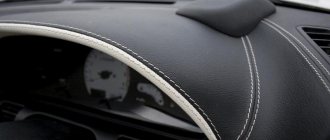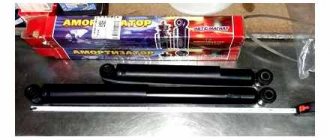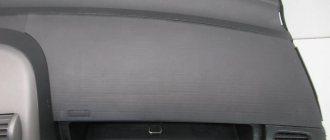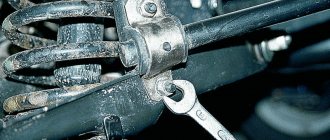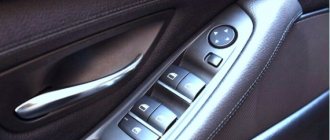Every driver who frequently travels not only on the highway, but also around the city, is familiar with the situation - a flat tire. Very lucky are those owners whose “four-wheeled” friends are equipped with a “spare wheel” and other tools for changing a wheel: the first place of which is a jack. After all, without it, even if you have a spare tire, you certainly won’t be able to replace it right on the road!
Recommendations for using a jack.
How to properly install a jack.
First of all, the jack must be placed on a flat, hard surface. In no case should you jack it up on sand, gravel or crushed stone, as on this surface the jack will probably go a couple of centimeters below, or even to the side. Try driving on a flat tire to a hard surface, at a distance of 100-200 meters, and if you don’t drive fast, nothing will happen to your tires and wheel. If this is not possible, then place a board under the jack that will withstand the load of the car. If all of the above fails, it is better to call a mobile tire service, since your car will probably come off the jack and bend the stiffener and the paint layer of the car.
The jack must also be installed exactly perpendicular to the car. When changing the radius of the jack, it may bend under the pressure of the car, which will lead to the car falling. As you already understand, even at the initial stage you need to follow quite a few rules, since failure to comply with them can lead to unnecessary repair costs for both the car and the jack.
Where to put the jack pad
The jack pad must be installed under the stiffening rib of the car; this applies mainly to sedans and hatchbacks. If there is none, then a cushion is installed under the frame or wheel lever; this applies more to SUVs. Often on new cars the entire bottom is covered with plastic, including the stiffener. In this case, you need to find a place where the plastic on the edge has a plastic island measuring 10-15 cm. If you are afraid to jack up under the plastic, try doing it under the lever. In Mercedes, BMW, Bentley and several other brands of cars, there are special jack pads on the bottom, but there are times when these pads are torn off, you can safely jack the car to the place where these pads are attached.
It is necessary to jack up smoothly; after reaching the required height, fix the jack; if there are supports, install them.
So you have learned the theory of how to jack up a car correctly. Although in practice, it happens that everything turns out to be much more complicated. If you are not ready or are afraid to do the above on your own, our mobile tire service is ready to come to your aid around the clock and do all the necessary work related to your wheels.
Important truths
The effectiveness and efficiency of a jack is determined at the stage of purchasing such a device. An important indicator when choosing is the carrying capacity of the models under consideration. It is logical that this value should not be less than the total mass of the vehicle.
So, for a car weighing 800 kg, it would not be superfluous to place a jack with a lifting capacity of 1 ton in the trunk. But you should not try to lift a larger vehicle with such a device. Overloading will cause the lifting unit to break down and, as a result, cause damage to the car.
Moreover, a car falling from its support can pose a serious threat to life and health for a person in close proximity to it.
Installing a standard jack
Let's look at the diagram for installing a standard jack on a Renault Duster:
- We take out the jack from the luggage compartment. Before installation, you must park the car on a flat surface, asphalt or in a garage.
- The standard jack has a special hook that needs to be inserted into the hole under the threshold. You need to hook from the bottom.
Protrusion for standard jack
Slot in standard jack
- Now we turn the handle and the jack begins to open. The lower, supporting part should sit flat on the surface.
- We turn until the car rises to the desired height.
Installing a jack is a fairly easy operation and does not require special knowledge and skills.
Video of modification of standard jack
Installation of other types of jacks
Hydraulic bottle jack
Some jacks do not have a hook, but simply a notch on the top platform. It needs to be placed under the ledge on the car, which is located under the threshold.
Jack lug close up
You can also use a hydraulic jack, which is also placed under this rib. All jacks are installed in the place where the threshold connects to the bottom and has a so-called rib.
Ways to jack up a car correctly
Every driver who frequently travels not only on the highway, but also around the city, is familiar with the situation - a flat tire. Very lucky are those owners whose “four-wheeled” friends are equipped with a “spare wheel” and other tools for changing a wheel: the first place of which is a jack. After all, without it, even if you have a spare tire, you certainly won’t be able to replace it right on the road!
Recommendations for using a jack.
where to put the jack vaz 2114
Correct replacement of wheels on VAZ 2108-VAZ 2115
An auto wheel is what the car rides on, and also uses it to brake, turn and do many other things. But there are situations in which the wheel gets punctured or something else happens to it because of which the car cannot continue to move fully, and when this happens the question immediately arises: “How to change a tire on a car?” We will tell you how to do this. We'll sort it out with you now.
To change a wheel, you will need to stock up on: Firstly, a jack, in order to lift the car into the air, as well as bricks just in case (If you have them on hand), you will definitely need to stock up on a wheel wrench and a knife or with a screwdriver (Optional), and you may also need a flat piece of wood (In this case, if you will be replacing a wheel not on asphalt, but for example on grass, or simply on soil on which it is typical for gravity to settle on it) , and finally, just in case, take a pump at the end of the operation you will need it!
Preparatory actions
Before you begin installing the jack, you need to tighten the handbrake and select parking gear. Next you need to loosen the bolts on the wheels. If the car has a lock, then you will need to loosen it first, and only then the other nuts and bolts. Once you have completed all of the above steps, you can proceed to installing the jack.
How to replace a wheel on a VAZ 2108-VAZ 2115?
By the way, it is also recommended to replace a wheel using a torque wrench, since bolts that are tightened differently (with different forces) can even break the part of the disk in which they are located, for example, try to tighten three bolts with a small amount of force, and one of all four with very strong force and after hitting a bump, most likely in the place where one of the bolts is tightened the disk will be very damaged, since all the force during a collision will go specifically to this part of the car’s wheel
1) At the very beginning of the operation, it is recommended to loosen, but not completely unscrew, all the wheel bolts on the car.
In all cases, take note that it is necessary to loosen the wheel bolts when the car is standing with all its weight on the ground, because if you decide not to loosen the bolts while the car is standing on the ground, but decide to immediately unscrew them when you lift the car into the air, then it may Even if you jerk the part with your hands, the car will most likely fall off the jack and you will have to lift it again!
Where to put the VAZ jack
Where is the right place on a VAZ to remove a wheel?
HOW TO CORRECTLY JACK A CAR WITHOUT CONSEQUENCES.
How to properly jack up a car, what places it is safe to place the jack in without harming the bodywork.
2) Then, when the bolts are slightly loosened, bring the jack to a suitable place on the car and then use it to carefully and slowly lift the car so that the wheel hangs in the air.
If you don’t understand where you need to place the jack under the car, we’ll explain! The jack is installed under three different places chosen at your discretion, namely under the threshold itself, or under the spar, or under the cross member of the car!
3) Then, when your car is hanging in the air, you can put bricks under the wheels chosen in connection with the situation so that the car stands and does not roll anywhere if something happens, for example, if your car is parked on a hill and its front part is raised up up, then it will certainly be necessary to slip a jack under some rear wheel so that the car does not fall off it. (In almost all cases, by the way, it is recommended to place bricks under the wheels so that the car does not simply sway from side to side)
In general, the ideal thing is not to change the wheel at all on a hill, but still there are various situations in life, sometimes even on muddy soil you have to change the wheel, for example, you went to the dacha after the rains and the road was bad and here, as luck would have it, the right tire, for example, went flat from hitting a nail or something else! (By the way, in this case, if you change the wheel not on a hard surface but on a soft one, then it is recommended to slip some kind of plank under the jack so that the car does not fall off it, and if you change it on a very soft surface, let’s say on mud, then in this case It is recommended to push the car onto a harder surface, otherwise you most likely will not be able to change the wheel at all)
4) After the wheel is hung and bricks have been placed under the wheels just in case, unscrew all the bolts that secure the wheel to the car, and after unscrewing, carefully remove it from the car.
Before unscrewing the bolts, use a knife or screwdriver to pry off the protective cap of the hub and then remove it from the wheel!
Installing new wheels is done in the reverse order of removal, but just always remember that it is necessary to tighten all the bolts that secure the wheel one hundred percent only in this case when the car will stand with its entire weight on the ground and not hang in the air, and to all this, tighten the bolts cross to cross.
When the wheel is installed on the car, be sure to check the air pressure in the wheel using a pump and pump it up if necessary!
But in no case do not tighten the bolts very tightly, specifically with your feet or very much with your hands, and make sure that the bolts are not too loose!
Lada Granta Red Lux Mechanics › Logbook › Stay alive. Raising the car with a jack
Everyone knows what a jack is and why it is needed. But, it’s amazing! Some people here sometimes use jacks, if not illiterately, then rather frivolously.
And this can lead to the car falling off the jack. Moreover, this may cause the car to fall directly on you, dear reader.
And nowadays, thanks to the widespread use of phones with FullHD cameras, you can’t really count on help.
How not to drop a raised car is the first question of this post.
Second question: What qualities should a car jack, which is so necessary on the farm, have? I'll start with this.
It is believed that it should be stable, durable, reliable, comfortable, light, small and cheap. Everything is clear, I think.
Durable and reliable means heavy and expensive. Light and cheap means it will collapse at any moment. And so on.
I'll say something blasphemous - the jack can be anything. If only it didn’t fall apart without declaring war. You just need to be able to use them correctly, and also know the weaknesses of different types of jacks.
The only caveat is that the passion for ultra-reliable rolling jacks, capable of lifting ten to fifteen Grants at a time and weighing over a hundred kilograms, is irrational. This type of jack is simply inconvenient! Due to the huge gear ratio, it will take half a day to pump the lever. And moving it across the floor does not apply to any other sport except weightlifting.
Which of the constantly carried jacks is the most versatile and convenient?
Personally, it has long been clear to me that there is nothing better than a diamond jack. When executed correctly, it is closest to the ideal.
In general, to put it simply, it is from the diamond jack that the car will fall last. From anyone, even not ideal.
The second place is deservedly occupied by the semi-diamond jack, a sample of which is available for study to every owner of the Grant. This type of jack has at least two weaknesses. The first is a small margin of lateral stability. Due to the rocking bottom heel, you need to use it wisely. When lifting a machine, it always moves by some amount from the lifter. The upper support of the jack moves along with the car. If initially the vertical axis of the jack was strictly perpendicular to the surface, then after lifting it will turn out to be inclined, so to speak, inside the car.
This is very dangerous, because no one can predict what angle of inclination will lead to the lower support of the jack “slipping out” and the car falling. This happens something like shooting out an orange seed held between your fingers - quickly and unexpectedly. It's better not to take risks. Therefore, when starting to lift, you need to place the bottom of the jack slightly under the upper support. Then, at the end of the lift, the vertical axis of the jack will become vertical.
The second problem with the semi-diamond jack is the reduced margin of longitudinal stability. Unlike a diamond, there is no necessary rigidity between the upper and lower supports. Therefore, if the car is not properly secured, it easily and naturally slides forward or backward from such a jack. In this case, the jack is twisted by the propeller, until it is completely unsuitable for further use.
The third place among mobile jacks is occupied by Y-shaped ones.
Vertical screw jacks are hardly worth considering as mobile or even garage ones. Their stability is fine, but the inconvenience of use is the highest of all jacks, in my opinion. But they are good to use as tragus, i.e. additional supports.
There are many similarities between them, but there are two fundamental points. The first is that a dolly requires much more space on the side of the car. Sometimes this is critical. The second is when lifting the car from both sides (i.e. the entire front or rear) using a rolling jack, you need two of them. I'll explain why below.
Finally, for those jobs that do not require (or directly prohibit) hanging the wheels, stands that you can drive onto are convenient. Such microoverpasses exist in many implementations, among which there are examples of grace and a complete collective farm. Some are difficult to make, and some are very simple. I use the simplest micro-overpass made of timber, which almost anyone can make. Here is one of its halves:
Then I’ll move on to the main question - how to lift and how to work with a raised machine. The first step is always chocks for the wheels. The stops should be placed under the diagonal wheel in relation to the one being hung. You don’t have to put the handbrake on, or engage any gears in the box, but the stops must be installed!
Why not a handbrake? But because there is never one hundred percent confidence in its uniformity. Just because it works doesn't mean it works equally on both wheels. As for engaging the gear, this is beyond good and evil, because the suspended front wheel automatically switches the gearbox to neutral))). Therefore, stops and only stops.
Then many people lift the car and quickly climb under it.
What cannot be used in this case are bricks. They do not withstand point loads well and collapse instantly, without the slightest warning.
The task of lifting a car, which already has so many important rules, is greatly complicated when it is necessary to hang the entire front or the entire rear.
The most common mistake is to borrow a rolling jack from a friend and start lifting the second side while the first side is hanging on a standard jack. The probability of the car falling from a standard jack in this case is close to one hundred percent. This is due to the fact that the rolling jack rolls freely on wheels wherever the car pulls it. Here, even additional support will not help the matter at all - the car will simply slide along it outwards from you, as if from a hill. And it will slide far if the support is stable, that’s the point! I was once convinced of this personally, and I testify to this. The car drove away a good thirty centimeters.
If it happens in a narrow garage, then the situation easily becomes tragicomic. The side is almost at the wall - no way to crawl through, no putting on a wheel, no jacking, no moving away. At least cry.
Therefore, if you need to hang the front or rear, be sure to use either two rolling jacks or two diamond-shaped ones. And be careful!
It is not without reason that they say that caution is the best part of courage.
When you're done working on the car, it's so nice to wash your hands! But there are no running water in garages. I recommend: the water consumption is small, it lasts for a long time:
UPD:
For everyone who is interested in the stand, I give its dimensions. This design is much more difficult to manufacture than simply fastening together two pieces of timber cut into a cone with a chainsaw. But it guarantees that the car will not roll off the stand. Because the wheel falls slightly (by 20 mm) into the hole.
All connections are made using screws of suitable length and metal plates.
— Height of end stops. If they are too high, the car will catch on them when driving. If they are too low, then when the wheel hits them, the stand will turn over and screw along the bottom.
— The size of the depression of the horizontal bar relative to the conical parts of 15-20 mm is the maximum at which the bottom of the structure can not be brought to the horizon at all. Those. do not process.
— Length of the horizontal platform. 370 mm is not much of a margin, less is not needed. More, however, too.
Source
Do not do that!
Let's talk not about how to use this device, but what not to do.
— You can’t leave the car standing on a jack. Use safety stands or support a wheel if the car falls off the jack to prevent it from crashing to the ground or crushing you. It’s not worth talking about the dangers to health, take care of yourself! The car can also be damaged from such falls.
Some drivers mistakenly believe that if you have a strong hydraulic jack, then there is no need to play it safe. It's a big mistake to think like that! Even the most reliable mechanism fails. So think about protection.
— Do not use a jack to support the bottom of the car. The metal there is not as strong as in other parts of the body, regardless of whether the car was made in the Soviet Union or came off the assembly line recently. With this method of use, you can deform the bottom. All this will lead to increased wear and corrosion.
— You cannot install the tool under moving parts of the car, for example, under the suspension. And there are many such wise men - they put a jack under the suspension arms. And then they repair the car after it falls on the asphalt.
— It’s also better not to put the thresholds under the soft part - it’s even thinner than the bottom. It is better to install it under the stiffening rib that is on the thresholds - on some cars, arrows indicate the place on the threshold where it can be placed. Classic domestic cars used to have special squares on the sills - for jacking. Otherwise, you will simply dented the threshold, and then you will have to go to a service center to correct your mistake and straighten the threshold. And why do you need additional expenses?
Don't make dangerous mistakes!
Follow the rules, do not act at your own risk. Otherwise, you will have to resort to expensive repairs later. Under some types of jacks you need to put thick rubber as a gasket. Make sure that the area you are working on is level.
Don't forget, a jack is a tool that lifts a car, not keeps it raised. Don't make dangerous mistakes, otherwise the car may land on your foot.
Tips from the professionals
Yes, of course, your main tasks are to choose the right place, as well as to install the jack efficiently (of proper quality). But! Do not be too confident in yourself; before performing these operations, carefully check the reliability of the jack, and also make sure how well your “four-wheeled” friend is fixed. Well, now you know that you shouldn’t be too careless with such “everyday” things as a jack. Yes, we wish that you don’t need it, but we nevertheless recommend that you always have it at hand in case “if something happens.”


